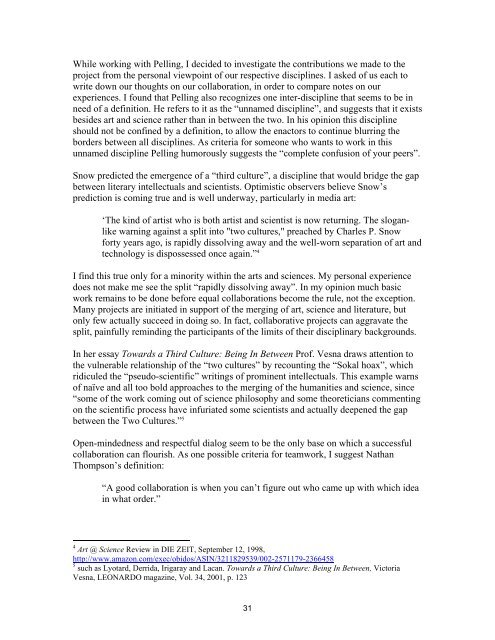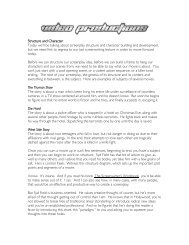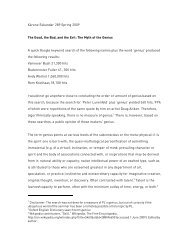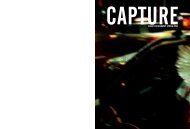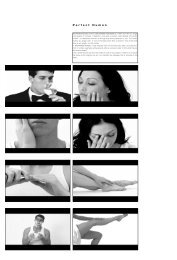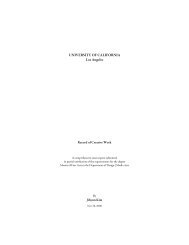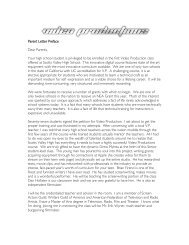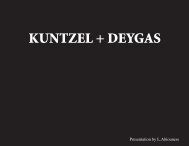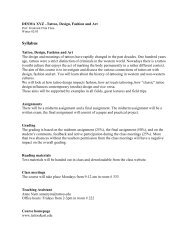Singing cells, art, science and the noise in between - Users - UCLA
Singing cells, art, science and the noise in between - Users - UCLA
Singing cells, art, science and the noise in between - Users - UCLA
Create successful ePaper yourself
Turn your PDF publications into a flip-book with our unique Google optimized e-Paper software.
While work<strong>in</strong>g with Pell<strong>in</strong>g, I decided to <strong>in</strong>vestigate <strong>the</strong> contributions we made to <strong>the</strong><br />
project from <strong>the</strong> personal viewpo<strong>in</strong>t of our respective discipl<strong>in</strong>es. I asked of us each to<br />
write down our thoughts on our collaboration, <strong>in</strong> order to compare notes on our<br />
experiences. I found that Pell<strong>in</strong>g also recognizes one <strong>in</strong>ter-discipl<strong>in</strong>e that seems to be <strong>in</strong><br />
need of a def<strong>in</strong>ition. He refers to it as <strong>the</strong> “unnamed discipl<strong>in</strong>e”, <strong>and</strong> suggests that it exists<br />
besides <strong>art</strong> <strong>and</strong> <strong>science</strong> ra<strong>the</strong>r than <strong>in</strong> <strong>between</strong> <strong>the</strong> two. In his op<strong>in</strong>ion this discipl<strong>in</strong>e<br />
should not be conf<strong>in</strong>ed by a def<strong>in</strong>ition, to allow <strong>the</strong> enactors to cont<strong>in</strong>ue blurr<strong>in</strong>g <strong>the</strong><br />
borders <strong>between</strong> all discipl<strong>in</strong>es. As criteria for someone who wants to work <strong>in</strong> this<br />
unnamed discipl<strong>in</strong>e Pell<strong>in</strong>g humorously suggests <strong>the</strong> “complete confusion of your peers”.<br />
Snow predicted <strong>the</strong> emergence of a “third culture”, a discipl<strong>in</strong>e that would bridge <strong>the</strong> gap<br />
<strong>between</strong> literary <strong>in</strong>tellectuals <strong>and</strong> scientists. Optimistic observers believe Snow’s<br />
prediction is com<strong>in</strong>g true <strong>and</strong> is well underway, p<strong>art</strong>icularly <strong>in</strong> media <strong>art</strong>:<br />
‘The k<strong>in</strong>d of <strong>art</strong>ist who is both <strong>art</strong>ist <strong>and</strong> scientist is now return<strong>in</strong>g. The sloganlike<br />
warn<strong>in</strong>g aga<strong>in</strong>st a split <strong>in</strong>to "two cultures," preached by Charles P. Snow<br />
forty years ago, is rapidly dissolv<strong>in</strong>g away <strong>and</strong> <strong>the</strong> well-worn separation of <strong>art</strong> <strong>and</strong><br />
technology is dispossessed once aga<strong>in</strong>.” 4<br />
I f<strong>in</strong>d this true only for a m<strong>in</strong>ority with<strong>in</strong> <strong>the</strong> <strong>art</strong>s <strong>and</strong> <strong>science</strong>s. My personal experience<br />
does not make me see <strong>the</strong> split “rapidly dissolv<strong>in</strong>g away”. In my op<strong>in</strong>ion much basic<br />
work rema<strong>in</strong>s to be done before equal collaborations become <strong>the</strong> rule, not <strong>the</strong> exception.<br />
Many projects are <strong>in</strong>itiated <strong>in</strong> support of <strong>the</strong> merg<strong>in</strong>g of <strong>art</strong>, <strong>science</strong> <strong>and</strong> literature, but<br />
only few actually succeed <strong>in</strong> do<strong>in</strong>g so. In fact, collaborative projects can aggravate <strong>the</strong><br />
split, pa<strong>in</strong>fully rem<strong>in</strong>d<strong>in</strong>g <strong>the</strong> p<strong>art</strong>icipants of <strong>the</strong> limits of <strong>the</strong>ir discipl<strong>in</strong>ary backgrounds.<br />
In her essay Towards a Third Culture: Be<strong>in</strong>g In Between Prof. Vesna draws attention to<br />
<strong>the</strong> vulnerable relationship of <strong>the</strong> “two cultures” by recount<strong>in</strong>g <strong>the</strong> “Sokal hoax”, which<br />
ridiculed <strong>the</strong> “pseudo-scientific” writ<strong>in</strong>gs of prom<strong>in</strong>ent <strong>in</strong>tellectuals. This example warns<br />
of naïve <strong>and</strong> all too bold approaches to <strong>the</strong> merg<strong>in</strong>g of <strong>the</strong> humanities <strong>and</strong> <strong>science</strong>, s<strong>in</strong>ce<br />
“some of <strong>the</strong> work com<strong>in</strong>g out of <strong>science</strong> philosophy <strong>and</strong> some <strong>the</strong>oreticians comment<strong>in</strong>g<br />
on <strong>the</strong> scientific process have <strong>in</strong>furiated some scientists <strong>and</strong> actually deepened <strong>the</strong> gap<br />
<strong>between</strong> <strong>the</strong> Two Cultures.” 5<br />
Open-m<strong>in</strong>dedness <strong>and</strong> respectful dialog seem to be <strong>the</strong> only base on which a successful<br />
collaboration can flourish. As one possible criteria for teamwork, I suggest Nathan<br />
Thompson’s def<strong>in</strong>ition:<br />
“A good collaboration is when you can’t figure out who came up with which idea<br />
<strong>in</strong> what order.”<br />
4 Art @ Science Review <strong>in</strong> DIE ZEIT, September 12, 1998,<br />
http://www.amazon.com/exec/obidos/ASIN/3211829539/002-2571179-2366458<br />
5 such as Lyotard, Derrida, Irigaray <strong>and</strong> Lacan. Towards a Third Culture: Be<strong>in</strong>g In Between, Victoria<br />
Vesna, LEONARDO magaz<strong>in</strong>e, Vol. 34, 2001, p. 123<br />
31


